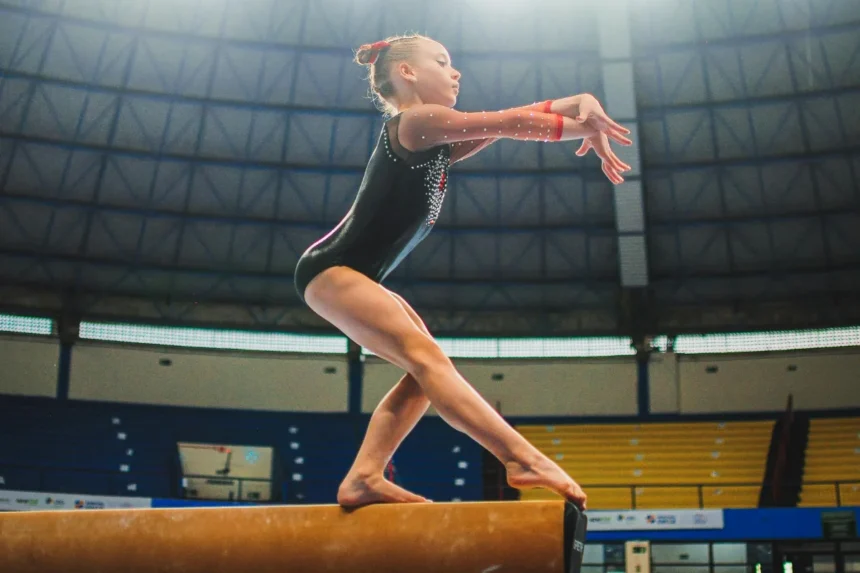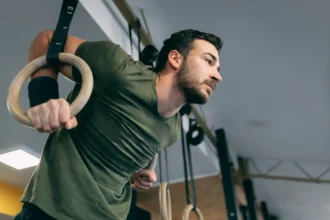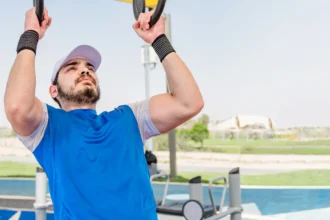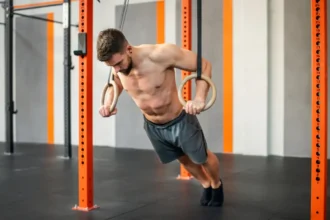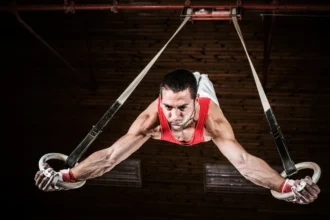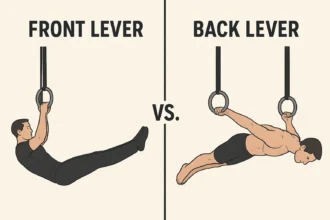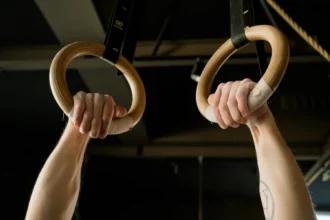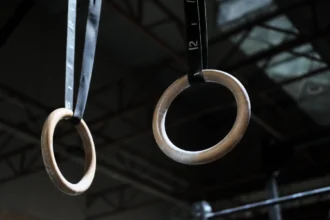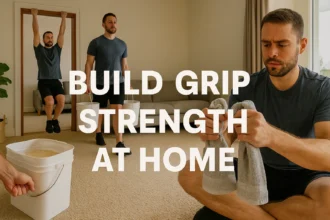For most gymnasts, learning to feel confident on the beam is a step-by-step journey. You start low, build your balance and skills, and move up only when you’re truly ready.
Skill progression on the balance beam is most effective when it follows a structured path. Most gymnastics programs follow a ladder that looks something like this:
- Floor Line Work
- Foam Beam Work
- Low Beam with Mats
- Low Beam without Mats
- Medium Beam Progression
- High Beam with Mats
- High Beam without Mats (Competition Readiness)
Here’s a closer look at every phase:
1. Floor Line Work
The first step in beam progression is floor line work, where gymnasts begin by walking, posing, and turning on a simple strip of tape or chalk (just 4 inches wide) to match the standard beam. It may seem basic, but this phase lays the foundation for everything that follows.
At this level, the focus is on learning movement patterns without any fear of falling. The athlete can fully concentrate on form, posture, and spatial awareness.
Key skills introduced:
- Relevé walks (forward, backward, sideways)
- Beam-style lunges with proper arm positioning
- Arm positions (T, overhead, and crown)
- Quarter and half turns in place
- Basic poses and balance holds (e.g., arabesques, scales, passés)
This stage is also useful for correcting early foot placement and helping gymnasts develop consistent core engagement and coordination before ever stepping on an actual beam.
2. Foam Beam Work
Once the gymnast is confident on the line, the next step is foam beam work. A foam beam, also known as a floor or practice beam—is soft, low to the ground, and shaped like a real beam. It introduces the gymnast to the narrow surface while keeping them safe and comfortable.
The low, padded setup encourages exploration, reduces fear of falling, and helps athletes feel what it’s like to move on a beam-width surface.
Typical skills practiced here include:
- Forward, backward, and side walking drills in relevé
- Early choreography poses and combinations
- Jump shapes (tuck, straddle, split)
- Basic handstand entries and cartwheel preps
- Static holds (arabesques, scales, passés)
This phase bridges the gap between floor and elevation by developing comfort on the actual width and surface feel of the beam, without adding the pressure of height.
3. Low Beam with Mats
Once the gymnast has solid control on the foam beam, it’s time to move onto a low beam, generally 4 to 12 inches off the ground, surrounded by soft panel mats. The beam surface is the same as a high beam: firm, suede-covered, and narrow. What makes this phase accessible is the protective padding around it.
Here, gymnasts begin to transition from flat ground to a more realistic elevated setting while staying safe. The goal is to become familiar with the firmness and feedback of a real beam while reinforcing previously learned skills.
Skills commonly developed:
- Beam mounts (squat-on, straddle-on, or side sit)
- Cartwheels, handstands, and walkovers with soft landings
- Jumps and leaps with clean technique
- Turns, pivots, and early combinations
- Short sequences combining acro and dance
This stage helps gymnasts start to feel the beam under pressure and prepare for controlled movement at height.
4. Low Beam Without Mats
When gymnasts show consistency on the low beam with mats, the next step is to remove the extra padding. While the elevation remains the same, the mental challenge increases—there’s now no room for sloppy landings or casual steps.
Every skill must be performed with intention, balance, and clean execution. Gymnasts must be able to stay centered, recover from wobbles, and demonstrate control without relying on a safety net.
Focus areas:
- Clean, centered landings after jumps and acro skills
- Stability in poses and turns
- Smooth, connected transitions
- Refined posture, toe point, and arm control
- Safe, consistent dismounts (jump-off or side handstand)
This is a polishing phase. The gymnasts are mastering what they already know and preparing mentally to take it higher.
5. Medium Beam Progression
The medium beam (usually 24 to 36 inches off the ground) is a valuable step in the beam journey. It offers just enough height to challenge the gymnast’s confidence, while still keeping risk and fear at a manageable level.
Gyms may use crank beams that can be raised incrementally or low beams elevated with sturdy blocks. This allows coaches to customize the challenge based on the gymnast’s comfort level.
Ideal skills to reinforce:
- Connecting acro elements (e.g., cartwheel to handstand, walkover series)
- Full jumps and leaps with strong landings
- Turn combos and choreography flow
- Higher dismount landings (onto soft surfaces)
- Rhythm and timing during short sequences
The medium beam helps gymnasts build trust in their abilities as they start to see the floor a little farther away, but still feel safe enough to focus on refinement and composure.
6. High Beam with Mats
Now comes the big step: the high beam, set at competition height 125 cm (just over 4 feet). Even for gymnasts who are physically ready, the height alone can stir up nerves. That’s why this stage includes crash pads, side mats, and spotting aids to ease the mental transition.
The high beam with mats phase is all about applying everything the gymnast has already learned—just at a higher elevation.
Training goals include:
- Performing full dance and acro elements at height
- Running longer sequences or full routines with confidence
- Dismounting safely onto crash mats
- Enhancing artistic expression and presentation
- Practicing under light performance pressure
This phase is essentially a dress rehearsal for the competition. Skills stay the same, but the environment shifts dramatically. As gymnasts become more comfortable, mats can be gradually removed.
7. High Beam Without Mats (Competition Readiness)
This is the final stage—the real deal. On the high beam without mats, gymnasts must demonstrate total control, composure, and readiness to perform under judging conditions. There are no side mats. No crash pads. No spotters. Just the gymnast, the beam, and the routine.
Even though the surface hasn’t changed from the previous phase, the mental environment is completely different. Here, it’s all about consistency, confidence, and competitive polish.
What’s expected at this level:
- Clean execution of full routines from mount to dismount
- Strong rhythm and no pauses between elements
- Confident artistry, posture, and presentation
- Accurate landings and quick recovery from minor balance checks
- Meet-ready timing, composition, and performance presence
This is where the technical work turns into performance.
Skill Ladder on Low and High: A Sample Progression Plan
Here’s a breakdown of the typical skill progression across floor, low, medium, and high beam levels.
| Phase | Setup | Focused Skills |
|---|---|---|
| 1. Floor Line | Tape or chalk line | Walking drills, relevés, lunges, quarter turns |
| 2. Foam Beam | Soft, low-profile floor beam | Cartwheels, handstand entries, posture and shaping |
| 3. Low Beam + Mats | 4–12″ elevation with side mats | Mounts, basic acro, balance drills, walkovers, jumps |
| 4. Low Beam (No Mats) | Same beam, no mat support | Relevé turns, jump landings, simple dismounts |
| 5. Medium Beam | Adjustable 2–3 ft beam height | Connecting skills, short routines, precision control |
| 6. High Beam + Mats | Full height with crash pads | Single acro elements, choreography under pressure |
| 7. High Beam (No Mats) | Full height, no supports | Full passes, dance-acro combos, competition routines |
Coaches may adapt this ladder based on the gymnast’s age, level, and confidence:


